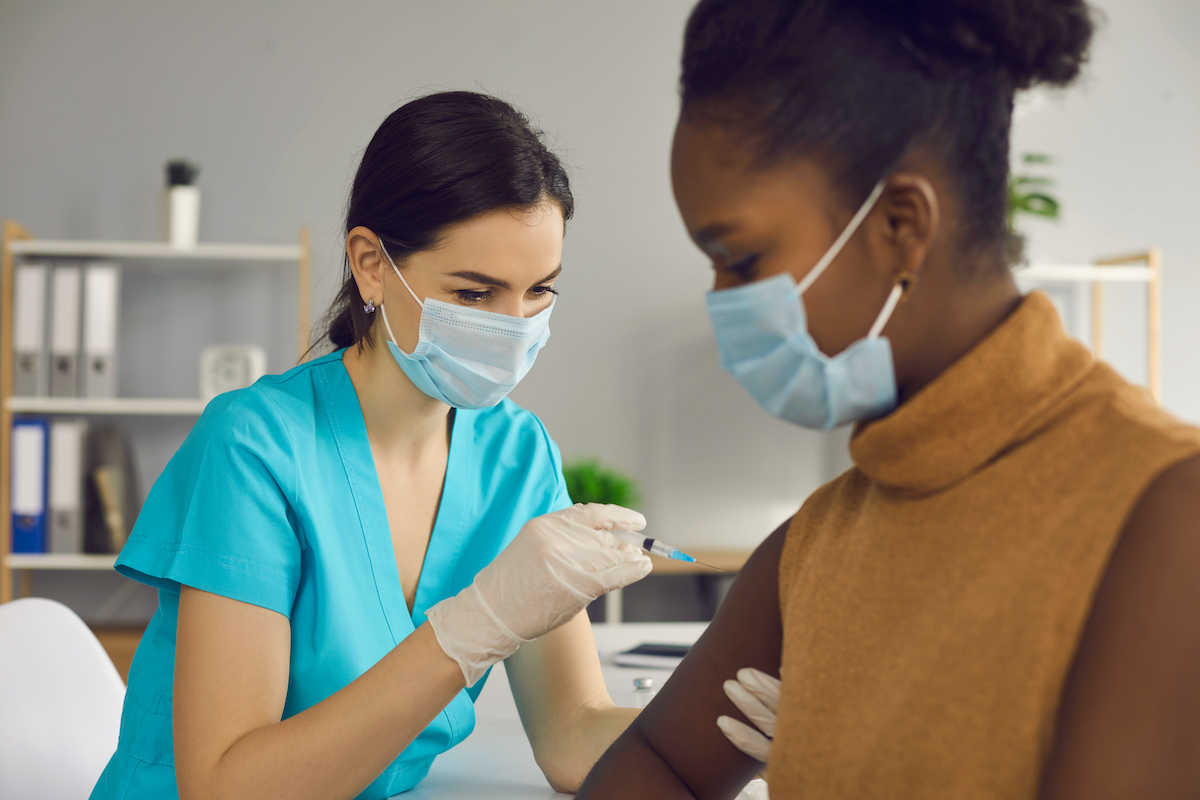By Sophia Kenward, SWHR Communications and Policy Intern
During the first month of COVID-19 vaccine distribution, 63% of people who received at least one COVID-19 vaccine dose identified as female, according to new data from the Centers for Disease Control and Prevention (CDC). This gender gap is not unexpected given that women make up three-fourths of health care workers and 65% of nursing home residents — two groups targeted in the first phases of the vaccine program.
In the absence of an overarching federal strategy, states have progressed at varying rates with the vaccine rollout. Vaccine distribution to states has been slower than expected, exacerbated by challenges in planning, coordination, and public communication. In the lead-up to the release of the first COVID-19 vaccines, former administration officials promised the U.S. would vaccinate 20 million people by the end of 2020. Unfortunately, the U.S. didn’t reach that goal until January 22, 2021. Delays in the vaccine rollout disproportionately affect women, who are more likely to be on the COVID-19 frontlines.
As public health officials and policymakers push forward with their vaccination strategies, they must ensure all women are protected from COVID-19 by removing barriers that may prevent them from getting vaccinated, including both vaccine hesitancy and access issues.
A clear gender gap exists in vaccine skepticism that aligns with the broader anti-vaccination movement that has become popular in online wellness communities. A December survey found that 45% of women would “probably not” or “definitely not” take a vaccine, as opposed to 33% of men. Many health care workers are also refusing the vaccine. In a survey of nearly 13,000 nurses (91% of whom were women), two-thirds said they would refuse the vaccine or were unsure of whether they would take it. Many workers in long-term care facilities have already refused the vaccine, despite the high death toll caused by COVID-19 in these facilities.
This vaccine hesitancy is fueled in part by misinformation and false claims, such as that the COVID-19 vaccine could cause infertility or even death. Some skepticism likely stems from lack of data about the effects of the vaccine in pregnant and breastfeeding individuals, who have historically been excluded from most medical research, denying them the information they need to make confident decisions about their health care.
Racial disparities are also apparent in vaccine uptake and acceptance. The CDC data show that race and ethnicity information is not available for 47% of vaccinated people and of those whose data was collected, about 60% of vaccine recipients are white. In states reporting vaccination data by race, white residents are being vaccinated at significantly higher rates than Black residents.
In the December survey, 57% of Black responders reported they would “probably not” or “definitely not” take a vaccine, as compared to 38% of white responders. Black Americans have experienced a long history of unethical research practices, resulting in a lack of trust in both the research process and health care system as a whole. The COVID-19 pandemic has exacerbated pre-existing racial and ethnic disparities in health care, and many people of color are weighing the decision to trust a system that has failed them. Rebuilding the trust of these communities is imperative to the success of the COVID-19 vaccine rollout.
Certain communities and groups of people may also experience greater challenges in accessing the vaccine. For example, pharmacy deserts exist in low-income and minority neighborhoods. As such, federally qualified health centers should be designated in neighborhoods that lack hospitals and pharmacies to assure those communities have access to the vaccine.
Women of color are more likely than any other group to work an essential job and should receive prioritized access to the vaccine. However, they may face obstacles to vaccination, such as finding child care or needing to take time off work to make a vaccine appointment. These women are less likely to have health insurance, and some may experience language and cultural barriers as well as fear of deportation if they are undocumented immigrants.
To alleviate the conflict between public health safety and employment obligations, some businesses like Dollar General and Trader Joes are offering paid leave to their employees to get vaccinated. To address transportation barriers, some local governments are setting up mobile vaccination units to travel to rural and low-income areas.
To combat vaccine skepticism, the government, public health officials, and communities must come together to develop a national strategy. Some effective strategies may include public endorsements of the vaccine by trusted leaders and framing vaccinations as a “public act” (like using “I voted” stickers and social media testimonials to promote voter turnout). The nonprofit Public Health Institute’s Berkeley Media Studies Group suggests meeting people where they are, clearly explaining the COVID-19 immunization process, and showing how the vaccine fits into the larger public health strategy.
Finally, President Biden recently signed an executive order establishing a COVID-19 Health Equity Task Force to address pandemic-related disparities, one of the new administration’s first steps in addressing access and trust issues among people of color and high-risk populations. A successful vaccine rollout will take an intersectional approach to target vaccine hesitancy and access issues and ensure that women —who are often making health care decisions in their communities and families — are as informed and empowered as possible.
